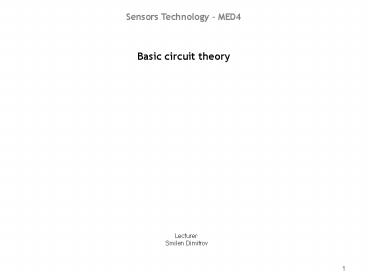Basic circuit theory - PowerPoint PPT Presentation
Title:
Basic circuit theory
Description:
Sensors Technology MED4 Basic circuit theory Lecturer: Smilen Dimitrov Introduction The model that we introduced for ST Introduction We have discussed The units ... – PowerPoint PPT presentation
Number of Views:191
Avg rating:3.0/5.0
Title: Basic circuit theory
1
Basic circuit theory
Sensors Technology MED4
Lecturer Smilen Dimitrov
2
Introduction
- The model that we introduced for ST
3
Introduction
- We have discussed
- The units of voltage, current and resistance, in
terms of electric circuits - The definition of an elementary electric circuit
- Ohms law
4
Resistors
- Construction of resistors
- Different sizes for different power ratings
- As far as construction of resistors goes,
generally we can discern - Carbon Composition Resistors
- Film Resistors
- Carbon Film Resistors
- Metal Film Resistors
- Metal Oxide Resistors
- Wire Wound Resistors
5
Resistors color code
- Ratings of resistors written as color code
6
Basic circuit theory
- Electrical circuit is a mathematical model that
approximates the behavior of an actual electrical
system. Circuit theory consists of models and
mathematical techniques - Circuits (also known as 'networks') are
collections of circuit elements and wires. - Electric circuits will be considered as graphs of
two types of elements nodes and branches. The
branches, which are electric components like
resistors and voltage sources, connect the nodes,
which can be viewed as representatives of voltage
potentials. - Circuit analysis is concerned with the
computation of voltages and currents in a circuit
for a certain excitation. There are various
methods for equation formulation for a circuit.
These are based on three types of equations found
in circuit theory - equations based on Kirchhoff's voltage law (KVL),
- equations based on Kirchhoff's current law (KCL),
and - branch constitutive equations.
7
Basic circuit theory
- Solving a set of equations that represents a
circuit is straightforward, if not always easy.
However, developing that set of equations is not
so easy. - The two commonly taught methods for forming a set
of equations are the node voltage (or nodal)
method and the loop-current (or mesh) method.
8
Basic circuit theory
- Conventions schematics
- While analysing a state of a circuit, one also
writes the direction of current and the polarity
of voltage in a schematic
9
Basic circuit theory
- Marking voltage
- Technical and real direction of current
10
Basic circuit theory
- Active and passive convention the elements
within a circuit will either control the flow of
electric energy or respond to it. - Open and Closed Circuits
- 'Shorting' an element
- Kirchhoff's laws are expressions of conservation
laws in physics, a conservation law states that
a particular measurable property of an isolated
physical system does not change as the system
evolves. A partial listing of conservation laws
that are said to be exact laws, or more precisely
have never been shown to be violated.
11
1st Kirchhoff (current) law - KCL
- Statement of the law of conservation of charge
what goes in, must go out - Or in particular the sum of currents going in
and out of a given node, is always equal to zero.
12
2nd Kirchhoff (current) law - KVL
- Statement of the law of conservation of energy
- The directed sum of the voltages (electrical
potential differences) around a circuit
(loop)must be zero. - Sum of voltages around every closed loop in the
circuit must equal zero. A closed loop has the
obvious definition Starting at a node, trace a
path through the circuit that returns you to the
origin node. - An element's voltage enters with a plus sign if
traversing the closed path, we go from the
positive to the negative of the voltage's
definition.
13
Ohms law and equivalence principle (Thevenin)
- Ohms law here is the branch equation for a
resistor - Equvalence principle - Thevenin theorem for
resistive circuits, it is possible that circuits
are represented through an equivalent circuit a
black box
14
Measurement
- Voltmeter is connected across two points,
ampermeter is connected through a point
15
Elementary electric circuit
- Simplest to solve using circuit theory
- Output voltage is simply equal to input voltage !
16
Series connection the voltage divider
- Our basic circuit in this course.
17
Series connection the voltage divider
- Our basic circuit in this course.
The input voltage E is divided in two
output voltages U1 and U2
The output voltage U2 is the input voltage
E, divided by
18
Equivalent resistance of series connection
- What does the power supply E see?
- The equivalent resistance for resistors in series
is, as a value, always dominated by the biggest
resistor in the sum
19
Parallel connection current divider
20
Parallel connection current divider
The input current I is divided in two
output currents I1 and I2
-gt
The output voltage is the same as the input
voltage !
21
Equivalent resistance of parallel connection
- What does the power supply E see?
- The equivalent resistance for resistors in
parallel is, as a value, always dominated by the
smallest resistor in the parallel combination.
22
Combined connection
23
Combined connection
To solve the circuit (find all the currents and
voltages, we must set a system of 6 equations,
using Kirchoff Laws and brach equations (Ohms
law).
The output voltage will be
24
Combined connection
Easier way to solve the circuit
Find equivalent parallel resistance
And solve a voltage divider....
The output voltage will be
25
Combined connection
- Important when Rih is almost infinite
simulates a connection of a voltage divider to
the data acquisition (Arduino)!
26
Analysis methods
- Just a mention of two analysis methods for
solving complicated circuits - Node Voltage Method (Nodal analysis)
- Loop Current Method (Mesh current analysis)































